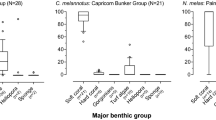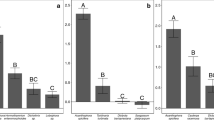Summary
The relationship between ichthyotoxicity and predation-related defensive functional morphology was examined in alcyonacean soft corals of the central and northern regions of the Great Barrier Reef (GBR), Australia. Approximately 170 specimens were assessed encompassing a number of genera within three families: 1) the Alcyoniidae (Lobophytum, Sarcophytum, Sinularia, Cladiella, Parerythropodium, and Alcyonium); 2) Neptheidae (Lemnalia, Paralemnalia, Capnella, Lithophyton, Nephthea, Dendronephthya, Scleronephthya, and Stereonephthya), and 3) Xeniidae (Anthelia, Efflatounaria, Cespitularia, Heteroxenia, and Xenia). Ichthyotoxicity data were derived from earlier studies which used Gambusia affinis Baird and Girard (Vertebrata, Pisces) as a test organism. These data were compared to morphological data collected from specimens in the field and laboratory. Three sets of statistical analyses were performed, each considering a progressively narrower group of taxa. The first included 68 specimens and considered 16 morphological characters in each, falling into the general categories of gross colony form, colony texture, presence of mucus, colony color, polyp retractility, and sclerite morphology and distribution. These were tested for independence against ichthyotoxicity data. The second set of analyses involved a more restricted morphological data set derived from 28 species of Sinularia in combination with 28 species within the Nephtheidae, comparing them to their respective toxicity ranks. The third analysis considered the previous two taxonomic groups separately in relation to their toxicity levels.
The attempt to consider many morphological characters in a taxonomically diverse collection did not reveal any general association in the Alcyonacea between defensive morphology and toxicity, and those associations which did emerge were clearly erroneous. The second analysis, considering only Sinularia spp. and nephtheids, demonstrated a negative association between ichthyotoxicity and the morphological characters of a) polypary armament, b) microarmament of the individual polyp, and c) strong mineralization of the coenenchyme. The third analysis revealed that the negative association found between toxicity and the first two characters was derived entirely from the nephtheids while the association detected between toxicity and the third character was restricted to Sinularia. It is concluded that a relationship between toxicity and morphology can be demonstrated, but it is heavily dependent upon which specific morphological characters are being considered and at what level of taxonomic resolution the analysis is being performed. An approach utilizing many characters over many taxa is unlikely to yield significant, reliable, or meaningful results.
Similar content being viewed by others
References
Atema J (1977) Functional separation of smell and taste in fish and crustacean. In: Le Magnen J, Mac Leod P (eds) Olfaction and Taste. vol. 6: Information Retrieval Ltd., London, pp 165–174
Bakus GJ (1974) Toxicity in holothurians: a geographical pattern. Biotropica 6:229–236
Bakus GJ (1976) The biology and ecology of tropical holothurians. In: Jones OA, Endean R (eds) Biology and geology of coral reefs. vol. 2: Academic Press, New York, London, pp 325–367
Bakus GJ, Thun MA (1979) Bioassays on the toxicity of Caribbean sponges. Colloq. Int. du C.N.R.S. 291, Biologie des Spongiaires 417–422
Bayer FM (1956) Octocorallia. In: Treatise of invertebrate paleontology. Part F: Coelenterata. Moore RC (ed) Geological Society of America, University of Kansas Press, pp 166–190
Bayer FM, Grasshoff M, Verseveldt J (1983) Illustrated trillingual glossary of morphological and anatomical terms applied to Octocorallia. Brill EJ, Backhuys W, Leiden, p 75
Birkhead WA (1972) Toxicity of stings of ariid and ictalurid catfishes. Copeia 1972(4):790–807
Brower LP (1969) Ecological chemistry. Sci Am 220:22–29
Coll JC, Sammarco PW (1983) Terpenoid toxins of soft corals (Cnidaria: Octocorallia): their nature, toxicity and ecological significance. 7th World Congr. Anim. Plant Microb. Toxins, Brisbane, Australia, 11–16 July 1982. Toxicon 1983, Suppl. 3:69–72
Coll JC, La Barre S, Sammarco PW, Williams WT (1982) Chemical defenses in soft corals (Coelenterata: Octocorallia) of the Great Barrier Reef: A study of comparative toxicities. Mar Ecol Prog Ser 8:271–278
Cornman I (1968) Drugs from the sea: Heterotargeting. In: Freudenthal HD (ed) Drugs from the sea. Trans. Symp. Univ. Rhode Island. Aug 1967 J Ocean Technol of Mar Technol Soc 1968:117–183
Dethier VG (1970) Chemical interactions between plants and insects. In: Chemical Ecology: Sondheimer E, Simeone JB (eds) Academic Press, New York, pp 83–102
Dinesen ZD (1983) Patterns in the distribution of soft corals across the central Great Barrier Reef. Coral Reefs 1:229–236
Dustan P (1975) Growth and form in the reef-building coral Montastrea annularis. Mar Biol 33:101–107
Eisner T (1970) Chemical defense against predation in anthropods. In: Chemical Ecology, Sondheimer E, Simeone JB (eds) Academic Press, New York, pp 157–217
Eisner T, Meinwald J (1966) Defensive secretions of arthropods. Science 153:1341–1350
Eisner TF, Katatos FC, Linsley EG (1962) Lycid predation by mimetic adult Cerambyeidae (Coleoptera). Evolution 16:216–324
Faulkner DJ, Ghiselin MT (1983) Chemical defense and evolutionary ecology of dorid nudibranchs and some other opisthobranch gastropods. Mar Ecol Prog Ser 13:295–301
Feeny PP (1975) Biochemical evolution between plants and their insect herbivores. In: Coevolution of animals and Plants: Gilbert LE, Raven PH (eds) University of Texas Press, Austin, pp 3–19
Fernandez Bernaldo de Quiros C (1978) Toxicity of technical Coumachlor and of Tomorin on Gambusia affinis. Boln R Soc esp Hist nat (Secc. Biol) 76(1/2):109–122
Fishelson L (1970) Littoral fauna of the Red Sea: the population of non-scleractinian anthozoans of shallow waters of the Red Sea (Eilat). Marine Biology 6:106–116
Freeland WJ, Janzen DH (1974) Strategies in herbivory by mammals. The role of plant secondary compounds. Am Nat 108:269–289
Glaser D (1966) Untersuchungen über die absoluten Geschmacksschwellen von Fischen. Z Vergl Physiol 49:492–500
Herbert P, Atema J (1977) Olfactory discrimination of male and female conspecifics in the bullhead catfish Ictalurus nebulosus. Biol Bull 153:429–430
Jackson JBC (1977) Competition on marine hard substrata: the adaptive significance of solitary and colonial strategies. Am Nat 111:743–767
Janzen DH (1969) Seed eaters versus seed size, number, toxicity and dispersal. Evolution 23:1–27
Jones DA (1962) Selective eating of the acyanogenic form of the plant Lotus corniculatus L. by various animals. Nature 193:1109–1110
La Barre SC, Coll JC (1982) Movement in soft corals: An interaction between Nephthea brassica (Coelenterata: Octocorallia) and Acropora hyacinthus (Coelenterata: Scleractinia). Mar Biol 72:119–124
La Barre SC, Coll JC, Sammarco PW (1986a) Chemical defenses in soft corals (Coelenterata: Octocorallia) of the Great Barrier Reef. II. The relationship between toxicity and feeding deterrence. Biol Bull 171:565–576
La Barre SC, Coll JC, Sammarco PW (1986b) Competitive strategies of soft corals (Coelenterata: Octocorallia) III. Spacing and aggressive interactions between alcyonaceans. Mar Ecol Prog Ser 28:147–156
Levinton JS (1982) Marine Ecology. Prentice Hall Inc. Englewood Cliffs N.J., p 526
Lewis JB (1982) Feeding behaviour and feeding ecology of the Octocorallia (Coelenterata: Anthozoa). J Zool 196:371–384
Ne'eman I, Fishelson L, Kashman Y (1974) Sarcophine — A new toxin from the soft coral Sarcophyton glaucum (Alcyonaria). Toxicon 12:593–598
Pianka ER (1974) Evolutionary Ecology. Harper & Row, New York. p 356
Ricklefs RE (1979) Ecology. 2nd Edn. Chiron Press, New York. p 966
Rideout JA, Smith NB, Sutherland MD (1979) Chemical defense of crinoids by polyketide sulphates. Experientia 35:1273–1274
Rowell CHF, Rowell-Rahier M, Braber HE, Cooper-Driver G, Gomez LD (1983) The palatability of ferns and ecology of two tropical forest gastropods. Biotropica 15(3):207–216
Sammarco PW, Coll JC, La Barre S (1985) Competitive strategies of soft corals (Coelenterata: Octocorallia): II. Variable defensive response and susceptibility to scleractinian corals. J exp mar Biol Ecol 91:199–215
Sammarco PW, Coll JC, La Barre S, Willis B (1983) Competitive strategies of soft corals (Coelenterata: Octocorallia): allelopathic effects on selected scleractinian corals. Coral Reefs 1:173–178
Schuhmacher H (1975) The role of soft corals (Alcyonacea, Octocorallia) in the reef biocoenoses of the Red Sea and the Australian Great Barrier Reef. Verh Dtsch Zool Ges 1974 (Stuttgart 1975):380–384
Schwartz CC, Reyelin WL, Nagy JC (1980) Deer (Odocioleus hemionus) preference for juniper forage and volatile oil treated foods. J Wildl Man 44(1):114–120
Sokal RR, Rohlf FJ (1981) Biometry 2nd edition. Freeman, San Francisco. p 859
Spiegelstein MY, Paster Z, Abbott BC (1973) Purification and biological activity of Gymnodium breve toxins. Toxicon 11:85–93
Strieck F (1924) Untersuchungen über den Geruchs-und Geschmackssinn der Elritzen. Z Vergl Physiol 2:122–154
Tursch B, Breakman JC, Daloze D, Kaisin M (1978) Terpenoids from coelenterates. In: Scheuer PJ (ed) Marine natural products: chemical and biological perspectives. vol. 2: 276–296. Academic Press, New York, London
Whittaker RH, Feeny PP (1971) Allelochemics: Chemical interactions between species. Science 171:757–770
Yamanouchi T (1955) On the poisonous substance contained in holothurians. Publications of the Seto Marine Biological Laboratory (Kyoto University) 4 No. 2-3:183–203
Author information
Authors and Affiliations
Additional information
Australian Institute of Marine Science Contribution Number 383
Rights and permissions
About this article
Cite this article
Sammarco, P.W., La Barre, S. & Coll, J.C. Defensive strategies of soft corals (Coelenterata: Octocorallia) of the Great Barrier Reef. Oecologia 74, 93–101 (1987). https://doi.org/10.1007/BF00377351
Received:
Issue Date:
DOI: https://doi.org/10.1007/BF00377351




